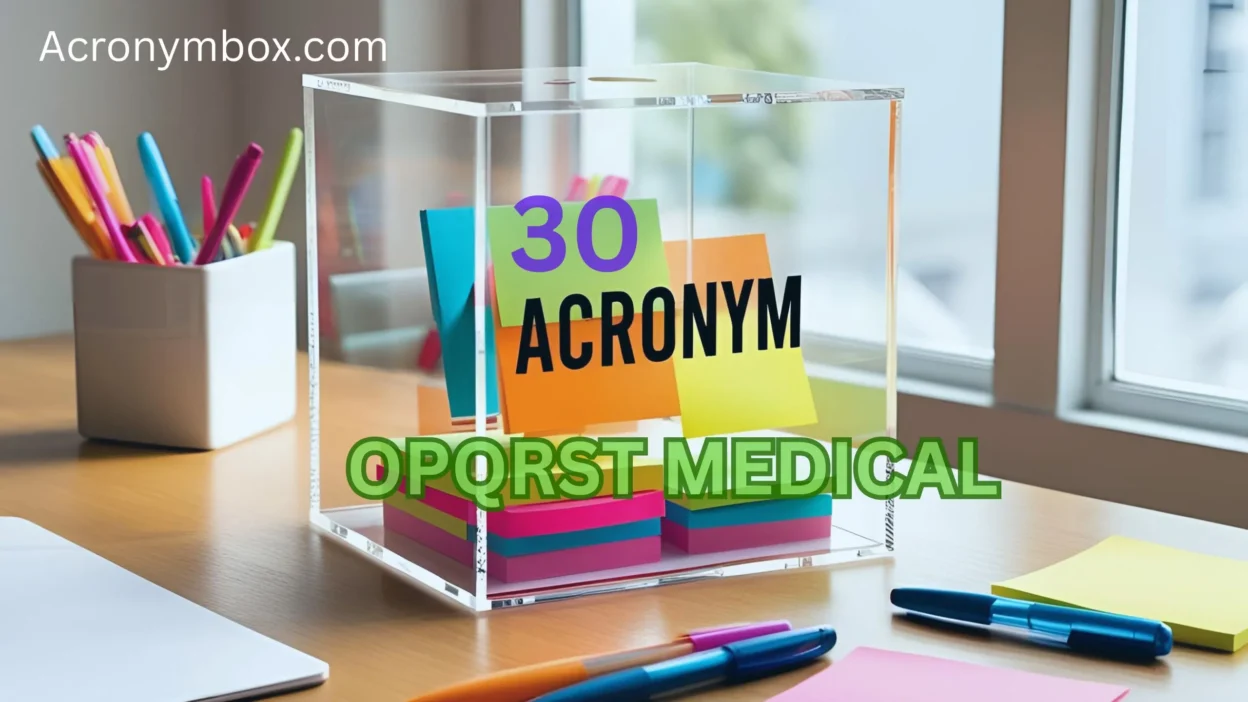When it comes to assessing pain in the medical field, few tools are as efficient and widely used as the OPQRST acronym. It’s not just a random set of letters—each one serves a specific purpose in helping healthcare professionals get a clear, structured, and detailed understanding of a patient’s pain.
In this article, we’ll explain the meaning behind the OPQRST acronym in medical settings, explore the traits it captures, and then introduce 30 alternative acronyms and phrases that healthcare workers can use based on different contexts and tones. Whether you’re a paramedic, nurse, doctor, or medical student, having flexible alternatives enhances communication and care.
🩺 What Does OPQRST Mean in Medical Terms?
OPQRST is a mnemonic used primarily in pain assessment. Each letter guides a healthcare professional through a specific aspect of the patient’s pain experience:
- O – Onset: When did the pain start?
- P – Provocation/Palliation: What makes it better or worse?
- Q – Quality: What does the pain feel like? (sharp, dull, burning, etc.)
- R – Region/Radiation: Where is the pain, and does it spread?
- S – Severity: How bad is it on a scale from 0 to 10?
- T – Time: How long has it been happening? Is it constant or intermittent?
This systematic approach is especially useful in emergency medicine where time is critical and information must be accurate.
🧠 Why Use Alternatives?
While OPQRST is thorough, healthcare is dynamic. Depending on the situation, specialty, patient age, or cognitive ability, a different acronym may be more appropriate. Pediatric patients, for instance, may benefit from more visual or simplified approaches. Mental health professionals may prefer models that focus more on emotional triggers than physical symptoms.
✅ 30 Alternatives to the OPQRST Acronym (With Context and Usage)
Here are 30 structured alternatives or complementary tools to OPQRST. Each one includes when it’s most appropriate and how to use it in a clinical setting.
1. OLD CART
Onset, Location, Duration, Character, Aggravating/Alleviating, Radiation, Timing.
Use in: Internal medicine, geriatrics.
“Can you describe when it started and how the pain feels?”
2. PQRST
Provocation, Quality, Region, Severity, Time.
Use in: Cardiology-focused assessments.
“Is your chest pain sharp or dull?”
3. SOCRATES
Site, Onset, Character, Radiation, Associated symptoms, Time, Exacerbating/Relieving, Severity.
Use in: Detailed musculoskeletal pain evaluations.
“Does the pain move anywhere else?”
4. ICE
Ideas, Concerns, Expectations.
Use in: Primary care, patient-centered communication.
“What do you think is causing the pain?”
5. AEIOU TIPS
Used to assess altered mental status: Alcohol, Epilepsy, Insulin, Overdose, Uremia, Trauma, Infection, Psychiatric, Stroke.
Use in: Emergency or mental status evaluations.
“Could it be a diabetic issue or head trauma?”
6. AMPLE
Allergies, Medications, Past medical history, Last meal, Events.
Use in: Trauma and surgical history-taking.
“When did you last eat?”
7. SAMPLER
AMPLE + Risk factors or Recent travel.
Use in: Infectious disease or travel-related illness screening.
“Have you recently traveled abroad?”
8. OPQRST-AAA
Extends OPQRST with Aggravating, Alleviating, and Associated symptoms.
Use in: Advanced pain assessments.
“What makes the pain worse or better?”
9. CHILD ALPHABET (Pediatric-focused acronym)
Crying, Hurting, Irritability, Loss of appetite, Drowsiness.
Use in: Pediatric triage.
“Has your child been unusually sleepy?”
10. LOCATES
Location, Onset, Character, Associated symptoms, Timing, Exacerbating, Severity.
Use in: Outpatient care and diagnostics.
“Does anything make the pain worse?”
11. SAMPLE
Symptoms, Allergies, Medications, Past medical history, Last oral intake, Events.
Use in: Pre-hospital and EMT evaluations.
“Any known allergies or medications you take?”
12. QRST
Quality, Radiation, Severity, Time.
Use in: Fast assessments, often in ER.
“Rate your pain from 0 to 10.”
13. TACOS
Tobacco, Alcohol, Caffeine, OTC, Street drugs.
Use in: Substance use screening.
“Do you use any over-the-counter drugs or supplements?”
14. PPP
Pain, Position, Provocation.
Use in: Quick OB/GYN assessments.
“Does the pain change with your position?”
15. COLDERAS
Character, Onset, Location, Duration, Exacerbating, Relieving, Associated, Severity.
Use in: Family medicine or nursing.
“Is there anything else happening along with the pain?”
16. ABCDE
Airway, Breathing, Circulation, Disability, Exposure.
Use in: Emergency and trauma settings.
“Let’s make sure they’re breathing first.”
17. FAST
Face, Arms, Speech, Time.
Use in: Stroke recognition.
“Did one side of their face droop suddenly?”
18. MIST
Mechanism, Injuries, Signs, Treatment.
Use in: EMS trauma handoff.
“The patient fell from a 10-foot ladder and has leg pain.”
19. DR ABC
Danger, Response, Airway, Breathing, Circulation.
Use in: Basic life support.
“Check for danger before approaching the patient.”
20. VINDICATE
Vascular, Infectious, Neoplastic, Degenerative, Iatrogenic, Congenital, Autoimmune, Traumatic, Endocrine.
Use in: Broad differential diagnosis.
“Could this pain be autoimmune-related?”
21. TITRATE
Type, Intensity, Timing, Region, Alleviation, Treatment, Evaluation.
Use in: Pain management clinics.
“Let’s adjust your treatment based on intensity.”
22. PAIN SCALE 0–10
Simple numeric assessment.
Use for: All pain check-ins.
“On a scale from 0 to 10, how bad is your pain now?”
23. FLACC
Face, Legs, Activity, Cry, Consolability.
Use in: Pediatric or non-verbal patients.
“The child scores a 6 on the FLACC scale.”
24. PAMI
Pain Assessment and Management Initiative.
Use in: Protocol-based clinical environments.
“We’re implementing PAMI guidelines today.”
25. SPINE
Stability, Pain, Injury, Neurology, Evaluation.
Use in: Trauma spine assessments.
“Is there any numbness in the legs?”
26. NUCA
Neurological, Urinary, Cardiovascular, Abdominal.
Use for: Quick system scan during acute care.
“Let’s do a NUCA check to rule out urgent issues.”
27. PIPER
Pattern, Intensity, Position, Effects, Relief.
Use in: Chronic pain tracking.
“What pattern do you notice about your migraines?”
28. HISTORY
History, Interventions, Signs, Treatment, Other info, Risks, Year.
Use in: Medical history collection.
“Let’s review your recent treatments and risks.”
29. NRS
Numeric Rating Scale (0–10).
Use in: General pain level tracking.
“How much pain are you in now?”
30. PEARL
Pupils Equal And Reactive to Light.
Use in: Neurological checks.
“PEARL was positive; pupils were equal and reactive.”
🧭 When to Use Which Acronym
Choosing the right acronym depends on:
- Urgency: Use ABCDE or FAST for emergencies.
- Detail: Use SOCRATES, LOCATES, or OPQRST-AAA for thorough analysis.
- Population: FLACC for infants, ICE for family medicine, OLD CART for elderly patients.
- Setting: Use SAMPLE in EMS, COLDERAS in nursing, and TITRATE in pain clinics.
Each tool adapts to different emotional, cultural, and clinical contexts—like how ICE focuses on empathy, and AEIOU TIPS checks for psychiatric conditions.
✅ Conclusion
Whether you’re in the ER, clinic, or ambulance, the OPQRST acronym remains a cornerstone of pain evaluation. But with so many variables—age, mental status, urgency—it’s essential to have other tools in your kit.
These 30 alternatives to OPQRST give you flexibility, clarity, and deeper patient insight. By matching the right tool to the right moment, you’ll deliver better care, build stronger patient rapport, and make faster, safer decisions.
Remember: in medicine, how you ask can be just as important as what you ask.




